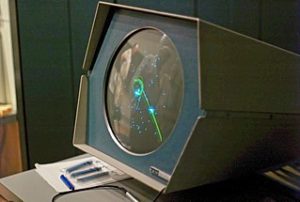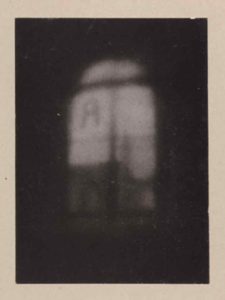An Ecology of Operations: Vigilance, Radar, and the Birth of the Computer Screen
by Bernard Dionysius Geoghegan
The essay begins:
 Computer screens emerged from the problem of integrating humans, computers, and their environment in a single problem-solving system. More specifically, digital graphics and computerized visualization emerged from the problem of integrating real-time human feedback into computerized radar systems developed by the US military in the early decades of the Cold War.1 In the course of the 1950s and 1960s tinkering engineers adapted techniques developed for visualizing enemy trajectories to somewhat less bellicose applications in computer graphics. Indeed, a wide variety of early computer-generated graphics—from John Whitney’s computer-aided animations and Ivan Sutherland’s Sketchpad program to early video games like Spacewar! and Tennis for Two—did little more than tweak the techniques of aerial defense into diversions like visualizing abstract patterns and intercepting, so to speak, an opponent’s tennis ball. To borrow film historian Kyle Stine’s felicitous phrasing, by folding picturing and calculation into dual aspects of a single process, these systems joined humans and calculating instruments in a single circuit of information processing. In fire-control systems (as mechanically aided approaches to tracking and targeting the enemy are often called), these feedback circuits often included the environment itself. Together, these elements of the system—human, instrument, environment—formed what I term an ecology of operations that distributed complex mathematical problems in recursive chains.
Computer screens emerged from the problem of integrating humans, computers, and their environment in a single problem-solving system. More specifically, digital graphics and computerized visualization emerged from the problem of integrating real-time human feedback into computerized radar systems developed by the US military in the early decades of the Cold War.1 In the course of the 1950s and 1960s tinkering engineers adapted techniques developed for visualizing enemy trajectories to somewhat less bellicose applications in computer graphics. Indeed, a wide variety of early computer-generated graphics—from John Whitney’s computer-aided animations and Ivan Sutherland’s Sketchpad program to early video games like Spacewar! and Tennis for Two—did little more than tweak the techniques of aerial defense into diversions like visualizing abstract patterns and intercepting, so to speak, an opponent’s tennis ball. To borrow film historian Kyle Stine’s felicitous phrasing, by folding picturing and calculation into dual aspects of a single process, these systems joined humans and calculating instruments in a single circuit of information processing. In fire-control systems (as mechanically aided approaches to tracking and targeting the enemy are often called), these feedback circuits often included the environment itself. Together, these elements of the system—human, instrument, environment—formed what I term an ecology of operations that distributed complex mathematical problems in recursive chains.
In the pages that follow I term this integration of visuality, calculation, territory, human problem-solving, and the human body in early information processing computational screening. At the most basic level, this term designates the productive integration of visualization technologies (that is, screen displays) and information processing (the screening and filtering of incoming data) that gave birth to digital graphics. Frequently, the screening of space (the flow of bodies across the membrane of a territory or through a battlefield) is also a key element of computational screening. As an analytical concept, computational screening calls attention to the history of computers as what Gilbert Simondon termed an “open machine,” reliant on continuous exchange with humans and their physical environment. In computational screening, visual, graphical, and optical media, as well as physical space and human bodies, collaborate in the production of circuits of computation. Although computational screening took shape in the complex human-computer systems of twentieth-century fire-control, today it includes a much wider array of problems involving conditions too complex to permit problem solving by computing machines alone (that is, without human support). The processing of crunchable social data by Facebook and the monitoring of traffic patterns by the navigation app Waze, for example, involve the development of sophisticated visual interfaces that entice humans to complete information processing tasks too complex for digital instruments alone. Indeed, the actualization of computers into something approaching Alan Turing’s universal machines is inconceivable without a vast array of visual interfaces that permit computers to enter into dynamic feedback loops incorporating input from users and their environments. Without the digital images enabling this circuit, the computer is little more than a fantastic automaton: that is, either an inert and preprogrammed bauble or a plaything that dwells in the imagination.
This article reconstructs a history of computational screening as it developed from naval artillery control systems developed just after World War II through the deployment of the Semi-Automatic Ground Environment (SAGE) computerized radar defense system shortly before the 1962 Cuban Missile Crisis. This historical arc emphasizes how the demands that modern warfare placed upon vision, territory, and attention in this period produced not only a new kind of digital image but also, specifically, a new kind of interactive image: one that enlisted bodies, attention, and calculation in the production of space. As art historian Pamela Lee has incisively written, “Cold War defense strategy could itself be described as a semiotic endeavor—an attempt to decode a shadowy enemy through a raft of signs both militaristic and cultural, including ‘indexical’ traces registered through the new technologies of radar; anthropological analyses of Soviet, Japanese, and German attitudes to authority; and the interactive dynamics observed within the ascendant field of the behavioral sciences.” I track one of these semiotic endeavors, the development of computational screening, an enterprise that drew on radar, computer science, psychology, moving images, physiology, geography, and other fields to establish a martial aesthetic that informs the attention economies of twenty-first-century digital cultures.
This history of computational screening and its alliance of visual interfaces with information processing reframes a much-discussed problem concerning vision and computing. Frequently, theorists of media and visual culture have argued that the computer is not a visual device. Media theorist Friedrich Kittler posited that in an age of electronic screens “visible optics must disappear into the black hole of circuits . . . [because] computers, as they have existed since World War II, are not designed for image-processing at all.” Germanophone media theorists Wolfgang Hagen and Claus Pias echoed Kittler, resolutely declaring in their respective theoretical sallies that “there is no digital image.” These and a host of other digital iconoclasts argue that, unlike traditional media such as photography, cinema, or painting that have a more or less determinate relationship to light, color, and spatial extension, electronic signals have neither a fixed nor an intrinsic relationship to vision. Often these theorists further maintain that the digital image lacks stable relationships to human bodies and space. For the proponents of digital iconoclasm, electronic pictures are like the afterimages that flicker into perception after the severing of an optical nerve: They may “look” like the real thing but they are the tricks of habituation, bereft of any correspondence beyond the random flickering of electrical signals. Continue reading …
Image: Spacewar! running on the Computer History Museum’s PDP-1. Photo: Joi Ito
In this essay Bernard Geoghegan examines the birth of interactive computer screens from enemy targeting and tracking systems (especially computerized radar) that distributed information processing in an ecology of operations among humans, computational instruments, and the environment. He proposes a concept of “computational screening” to account for the integration of visualization and information processing that gave rise to digital images.
 BERNARD DIONYSIUS GEOGHEGAN is a media theorist, historian of technology, and occasional curator. He teaches at the Department of Digital Humanities at King’s College London and can be reached online at www.bernardg.com or via Twitter at @bernardionysius.
BERNARD DIONYSIUS GEOGHEGAN is a media theorist, historian of technology, and occasional curator. He teaches at the Department of Digital Humanities at King’s College London and can be reached online at www.bernardg.com or via Twitter at @bernardionysius.



 In 1891, the Viennese physiologist Sigmund Exner published the first comprehensive study of complex, multifaceted eyes. Today, his book The Physiology of the Compound Eyes of Insects and Crustaceans is a classic in its field. Scholars still refer to Exner’s findings, even if “it took the scientific community 80 years to catch up with his state of knowledge.” The most popular outcome of Exner’s studies was a picture proudly printed opposite the title page. According to the caption, the figure shows “the erect retinal image in the eye of the firefly (Lampyris spldl.).” The original photograph was made with the help of Josef Maria Eder, author of the Handbuch der Photographie and renowned director of the Viennese Graphische Lehr- und Versuchsanstalt (Academy of graphic arts). Eder placed the eye—fully stripped of all tissue behind the lens structure—under a microphotographic apparatus, focused on the plane almost directly behind the inner endings of the ommatidia, and then recorded the image that would have formed at this point on the removed retinal layer. The resulting photograph shows the window of the laboratory room; the letter R, slightly distorted, mounted on one of its panes; and finally, beyond the pane, the “Schottenfeld Church and church tower, approximately several hundred paces distant” from the laboratory. This, at least, is what a human observer notices when studying the picture. Far more questionable is what the glowworm might see. Even if the photograph exactly reproduces the image “which the eye of the glowworm beholds,” as Eder claimed, it is not at all clear whether the resulting impression is comparable to the one perceived by a human being, and, even less clear, whether we can suppose that seeing always takes place in the same way.
In 1891, the Viennese physiologist Sigmund Exner published the first comprehensive study of complex, multifaceted eyes. Today, his book The Physiology of the Compound Eyes of Insects and Crustaceans is a classic in its field. Scholars still refer to Exner’s findings, even if “it took the scientific community 80 years to catch up with his state of knowledge.” The most popular outcome of Exner’s studies was a picture proudly printed opposite the title page. According to the caption, the figure shows “the erect retinal image in the eye of the firefly (Lampyris spldl.).” The original photograph was made with the help of Josef Maria Eder, author of the Handbuch der Photographie and renowned director of the Viennese Graphische Lehr- und Versuchsanstalt (Academy of graphic arts). Eder placed the eye—fully stripped of all tissue behind the lens structure—under a microphotographic apparatus, focused on the plane almost directly behind the inner endings of the ommatidia, and then recorded the image that would have formed at this point on the removed retinal layer. The resulting photograph shows the window of the laboratory room; the letter R, slightly distorted, mounted on one of its panes; and finally, beyond the pane, the “Schottenfeld Church and church tower, approximately several hundred paces distant” from the laboratory. This, at least, is what a human observer notices when studying the picture. Far more questionable is what the glowworm might see. Even if the photograph exactly reproduces the image “which the eye of the glowworm beholds,” as Eder claimed, it is not at all clear whether the resulting impression is comparable to the one perceived by a human being, and, even less clear, whether we can suppose that seeing always takes place in the same way.